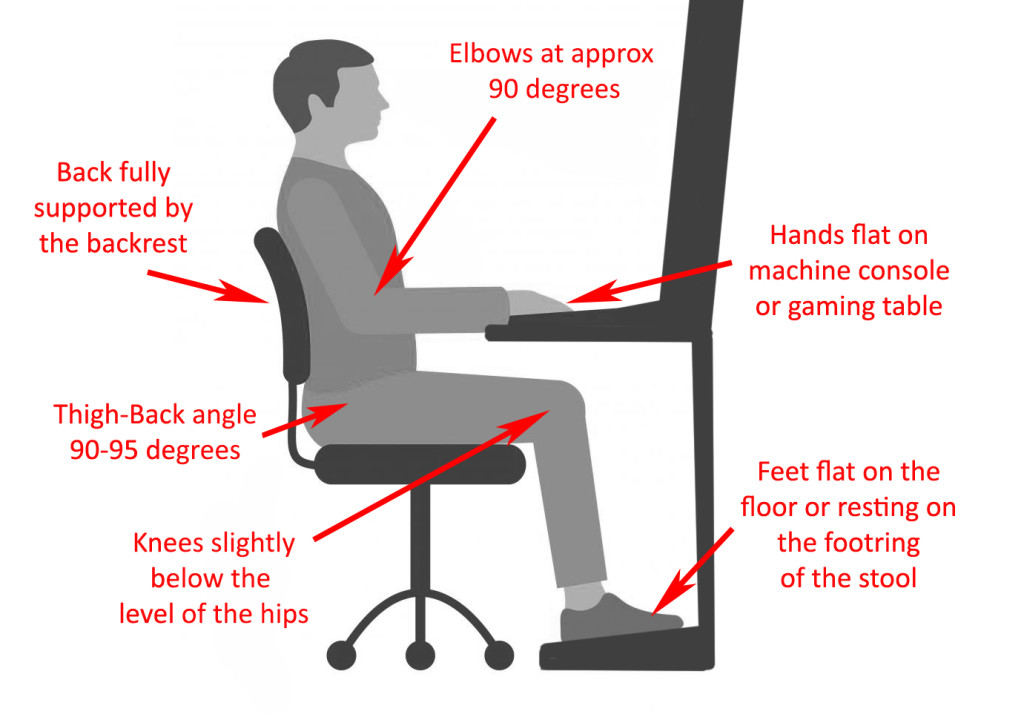
Gaming room ergonomics requires that the casino chair, the gaming table or machine, and the environmental factors like the lighting and air conditioning, are designed and adjusted to best suit the players.
Ergonomics is about designing the equipment and environment to optimally suit the people using it, and thereby reduce or prevent the user from suffering unnecessary fatigue, stress or injury.
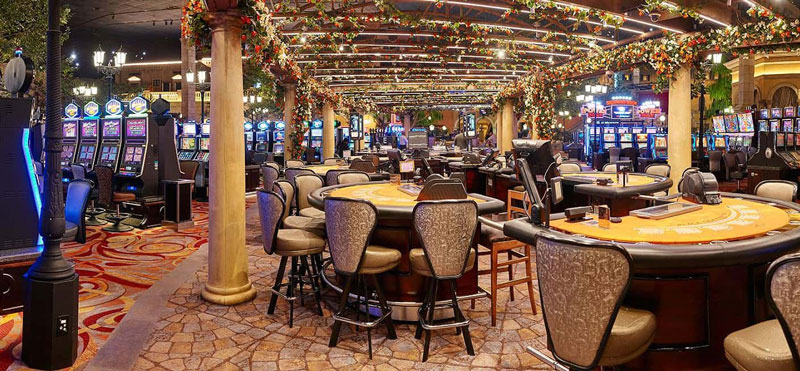
“An uncomfortable patron
often stops gambling and
may leave the property.”
Global Gaming Business Magazine
Many patrons spend hours sitting and playing machines or table games. According to Better Health (Vic), sitting for extended periods can result in health problems, the most common being:
- Neck pain
- Backache (lower & upper back)
- Shoulder pain
- Obesity
- High blood pressure
- Indigestion
- Weight gain around the waist
- Constipation
- Weakening of the large leg and gluteal muscles
- Chronic fatigue
- Deep vein thrombosis (DVT)
With patrons spending long hours in gaming venues, looking after their wellbeing is a priority. A review of gaming room ergonomics is essential.
Improving the ergonomics of a gaming room means designing the CASINO CHAIR, the GAMING MACHINE or TABLE, and the ENVIRONMENTAL factors TOGETHER. Unfortunately, the designers of the chairs, slot machines, tables, machine bases and gaming rooms, typically work in isolation. This leads to a sub-optimal ergonomic setup in the gaming room that directly compromises the health and wellbeing of the players.
1. The Ideal Ergonomic Seated Position in a Gaming Room
From an ergonomic perspective, players should be sitting as shown below:
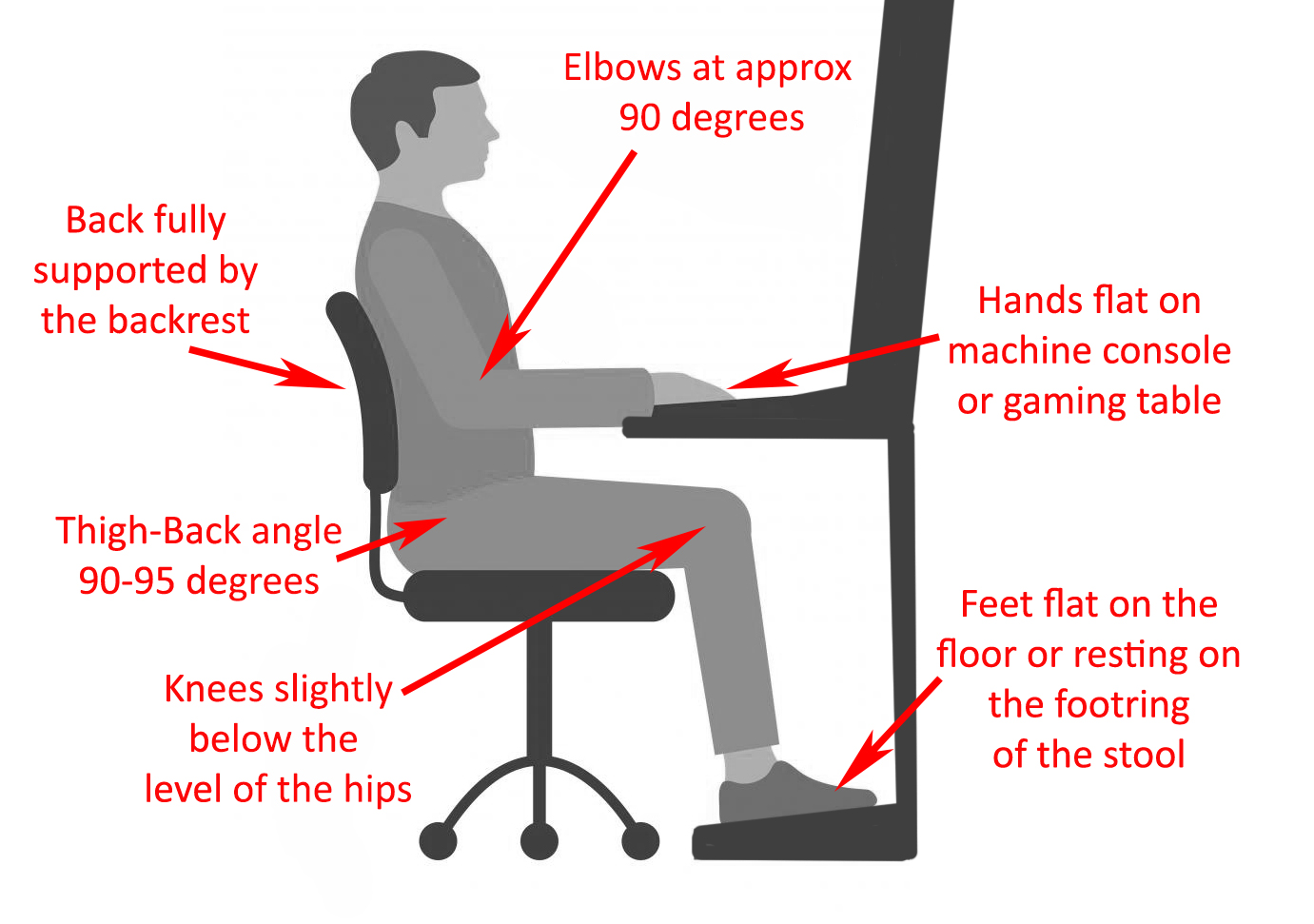
- Back fully supported by the stool backrest.
- Elbows bent at approximately 900
- Hands in-line with the machine console or top of the gaming table.
- Feet on the stool footrest or flat on the floor.
- Knees slightly below the level of the hips.
- Thigh-back angle 90-950.
2. How Players Usually Sit
Unfortunately, players seldom sit in the above ergonomically correct position. In most slot machine gaming rooms, patrons are usually seen sitting as shown below:
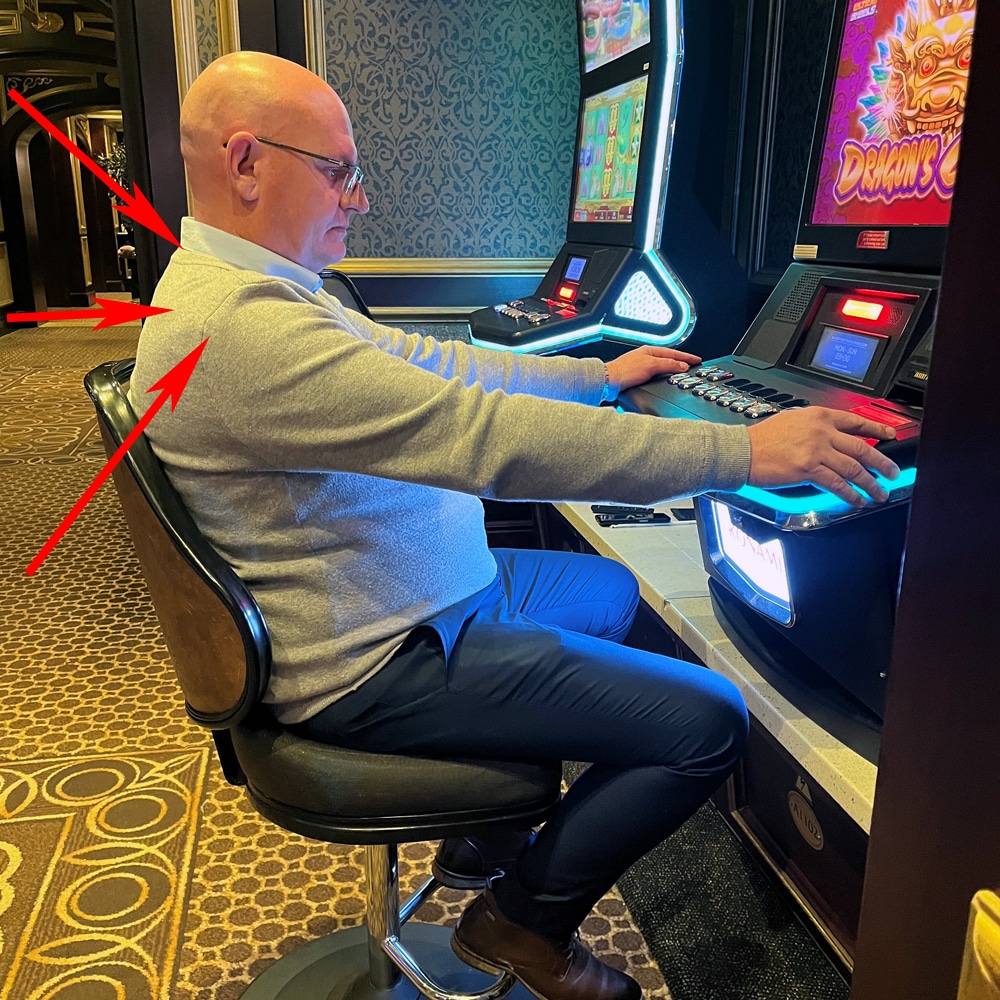
In Photo A, the player’s back is fully supported, and his ergonomic seated position is good. However, the machine base and playing console restricts him from sitting closer to the machine, and the only way he can reach the playing console is with fully outstretched arms.
Doing so results in muscular tension in the shoulders and neck which causes discomfort within a short period of time.
In an attempt to sit closer to the machine and avoid sitting with outstretched arms, players frequently move the stool closer to the machine and sit either sideways (Photo B), or with their feet on the machine base (Photo C).
Sitting sideways increases muscular tension in the lower back, neck and shoulders.
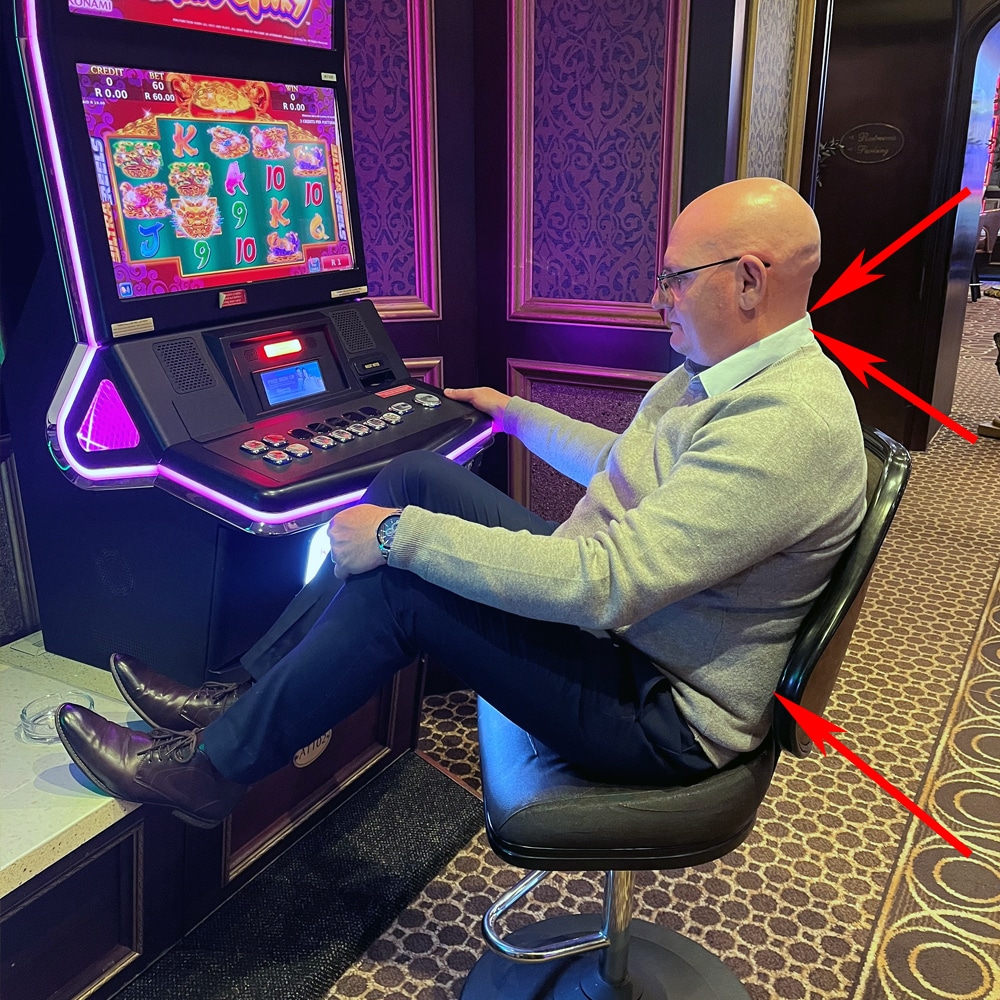
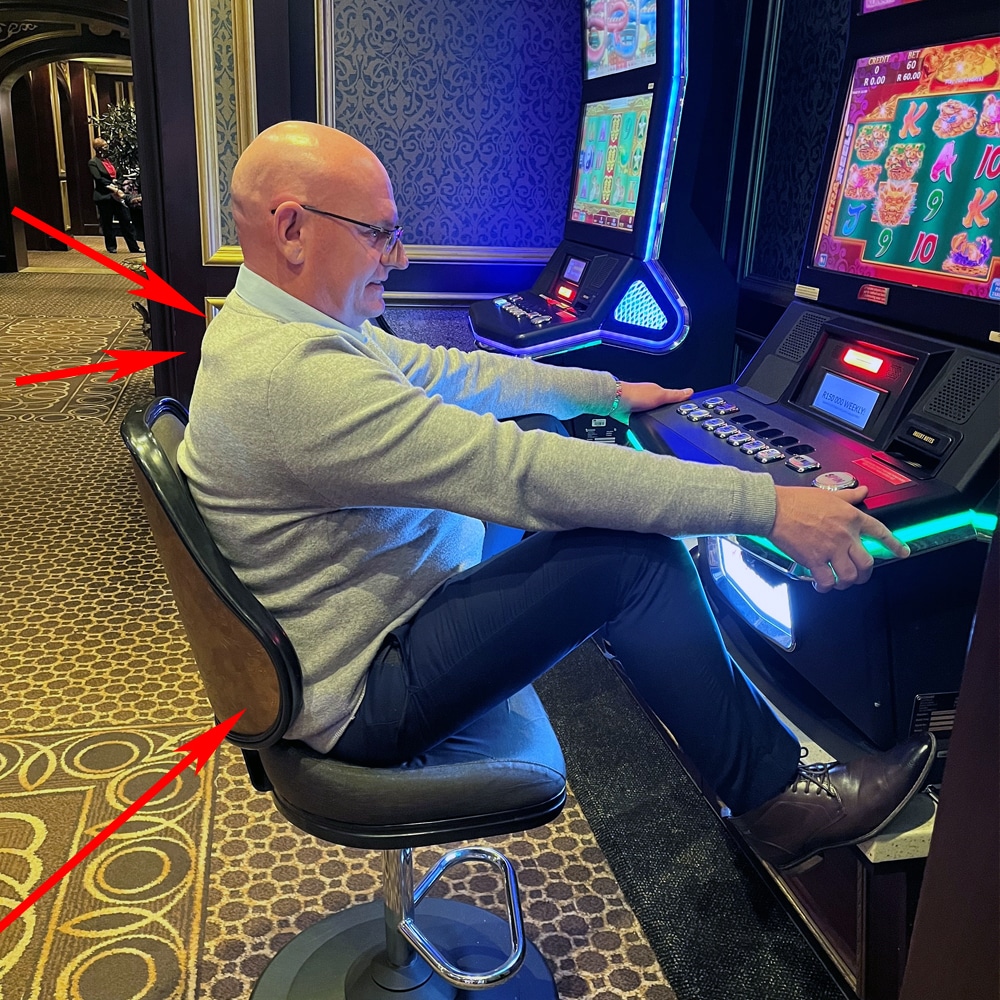
As in Photo B, sitting with your feet on the machine base reduces the distance to the machine, but increases the pressure in the lumbar spine.
In both photos B and C, the patron sits with their knees well above the level of their hips and a thigh-back angle less than 900. This increases the pressure in the lumbar discs resulting in lower back pain. Breaking Back – What actually happens when you sit?
Players not sitting as shown in either A, B or C, will usually sit on the front edge of the casino chair with their backs not touching the backrest of the stool. The resulting lack of back support causes muscular pain in both the lumbar and upper regions of the back. What is a good sitting position?
3. Why do patrons sit in an ergonomically incorrect posture at the gaming machines?
a. The player can’t get close enough to the machine console
Typically, the machine base and/or the design and position of the playing console prevents players from sitting close enough to the machine to adopt an ergonomically correct, and comfortable seated posture. To compensate, players either sit sideways (photo B), with their feet on the machine base (photo C), or on the front edge of the seat and don’t use the backrest of the chair.
Each gaming machine manufacturer has their own design preference for the position, angle and horizontal extension of the machine’s playing console. The height and the extension of the console is not standardised and differs from one manufacturer and machine type, to the next. In some cases, the console extends outwards towards the player. Provided the height of the stool is correct, an extended console improves the ergonomic setup by allowing the patron to sit facing the gaming machine with their feet flat on the floor or footrest, and their elbows bent at approximately 900 (arms not outstretched).
b. Fixed-height casino chairs don’t accommodate all players
Manufacturers of fixed-height casino chairs design their products to accommodate the “average” person, or roughly 90% of the adult population. In other words, 10% of all players will find the chair height to be incorrect. Anyone sitting on a gaming stool that is too low will have to stretch upwards to reach the console. Alternatively, someone sitting on a stool that is too high will have to stoop down. In both instances, this quickly results in muscular pain, particularly in the shoulders and neck.
Because venue operators typically have machines from multiple manufacturers in their gaming room, the actual height of the playing consoles varies throughout the gaming area. When you combine these variations with fixed-height casino chairs, it quickly becomes obvious that the chairs are suitable for only some of the players at some of the machines.
The two biggest contributors to poor ergonomics on the gaming floor are, (a) the position of the machine console and its distance to the player, and (b), casino chairs that are not adjustable.
c. The machine bases prevent players from sitting closer to the machine
Gaming machine bases vary in height as well as how close they will allow a patron to sit from the machine. In some cases, a recessed footrest is built into the base which, to some extent, improves the ergonomic setup as it allows the player to sit closer to the machine.
4. Improving Ergonomics in the Gaming Room
Improving the ergonomic setup in a gaming room requires a combination of the following:
a. Collaboration
Gaming room ergonomics requires a holistic approach. There should be greater collaboration between the designers and manufacturers of casino chairs, slot machines, gaming tables, machine bases and gaming rooms.
b. Casino chairs
For improved ergonomics, the design of casino seating should include the following:
i) Heigh adjustment
People have different body shapes and when it comes to chairs, there is no, and never will be, “one-size-fits-all”.
Gaming stools designed with ergonomics in mind, must be height adjustable.
Which casino chair base is best?
A fixed-height chair may look neater on the gaming floor, but they will only ever suit some of the players at some of the machines.
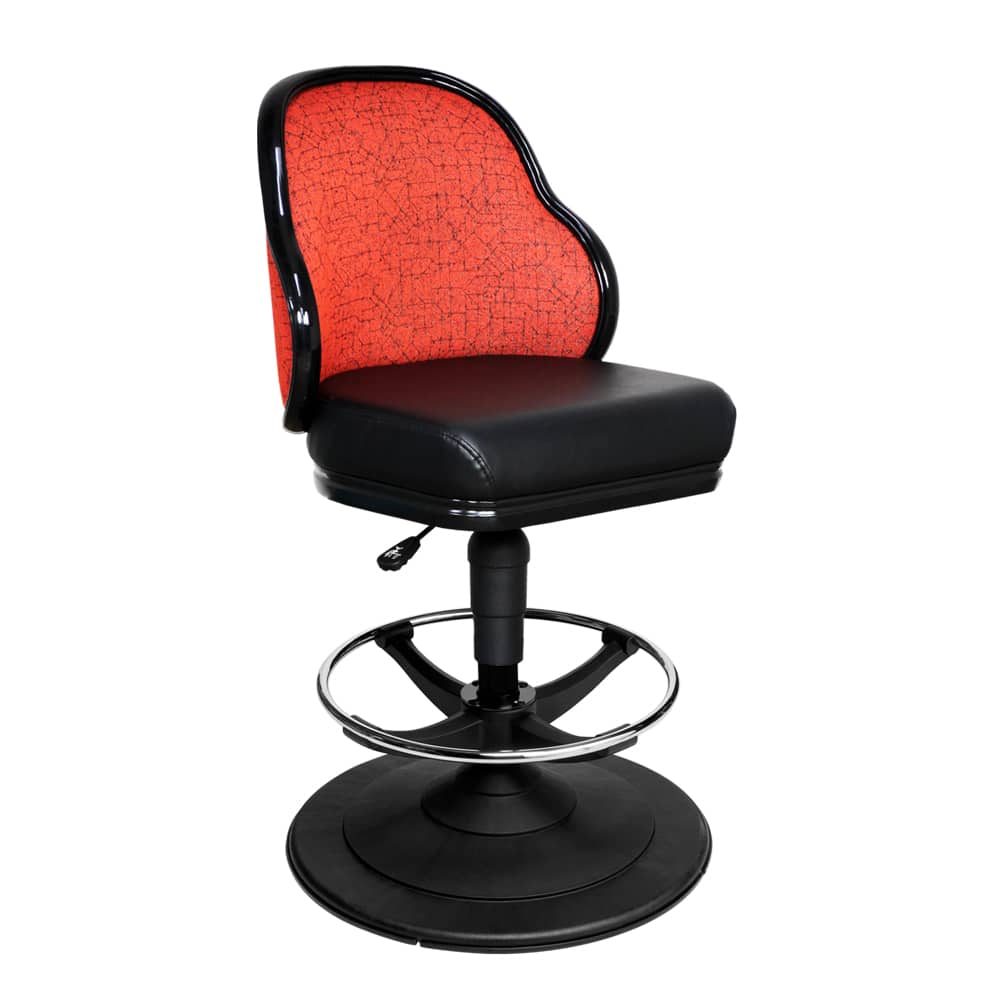
ii) Seat foam
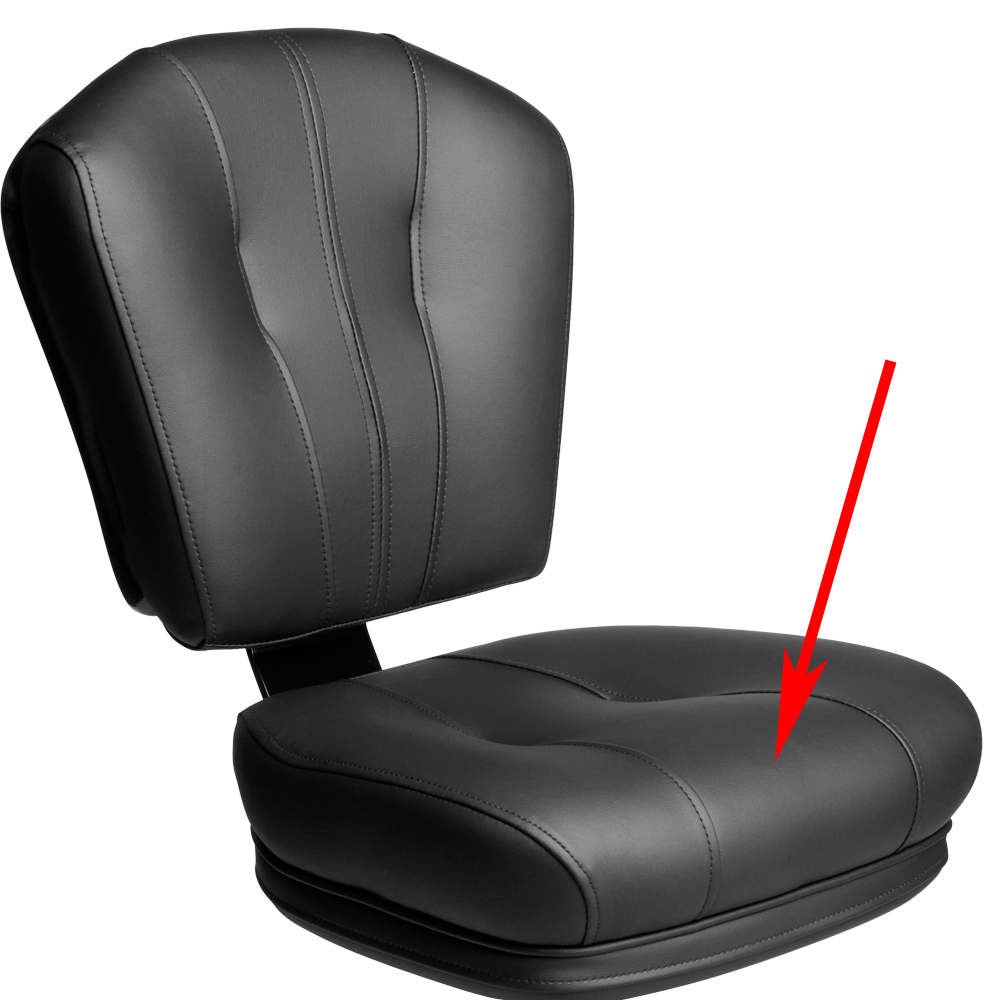
For improved long-term ergonomic comfort, casino chair seats should be manufactured from moulded foam.
The seat should also include a rounded or waterfall front edge to prevent point loading underneath the thighs.
iii) Seat depth
Although a longer or deeper seat is ergonomically better for taller players, the opposite is true for anyone who is short or of medium height. A longer seat forces short and medium height patrons to sit on the front-edge of the seat so that their feet can rest either on the floor or footrest. In doing so, they cannot reach the stool backrest and the resulting lack of back support causes muscular pain in both the lumbar and upper regions of their back.
While a casino chair with a seat-slider to adjust the seat depth would be ideal, it would add to the price tag. To avoid this additional cost and accommodate the vast majority of patrons, chair manufacturers opt for an internationally accepted seat depth that allows most people to sit in a comfortable and ergonomically correct position. Remember, there is no “one size fits all”.
c. Adjustable machine consoles
An adjustable machine playing console together with a height adjustable chair will dramatically improve the ergonomics in any gaming room.
d. Machine bases
The advent of cashless gaming reduces the restrictions on base designers and they, together with the machine manufacturers, should use this opportunity to work together to improve gaming room ergonomics.
e. Gaming room designers
Finally, room designers should not be afraid to include patron ergonomics in their layouts. A stylish and neat gaming room is not necessarily “ergonomic”, and room designers may need to make some design sacrifices to benefit the long-term wellbeing of the players.

